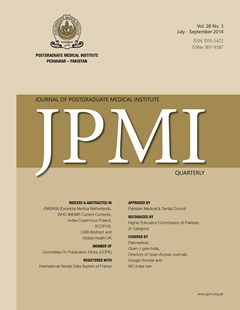Osteoporosis in healthy postmenopausal women
Main Article Content
Abstract
Objectives: To determine the frequency of osteopenia and osteoporosis using dual energy x-ray absorptiometry in healthy postmenopausal women within five years of onset of menopause and also to compare the menopausal symptoms between two different age groups.
Methodology: This cross sectional study was conducted at the outpatient department of Obstetrics and Gynecology, Fauji Foundation Hospital Rawalpindi from January 1st 2010 to May 31st 2010. DXA scan of the lumbar spine (L2- L4) and right hip (femoral neck) was requested. Osteoporosis was defined by a T-score of ≤ −2.5, osteopenia as T-score between −1 and −2.5, and normal BMD as T-score >−1. Menopausal rating scale was used and all findings were recorded in predesigned proformas.
Results: Out of a total of 33 subjects, who underwent dual energy x-ray absorptiometry, osteopenia and osteoporosis were found in 22 (66.7%) while only 11 (33.3%) have normal results. We took Null hypothesis H0: π=0.5 against the alternative H1: π>0.5. The test statistics is 22.4 and p value is zero. So H0 is rejected at all significance levels showing that ratio of abnormal DXA scan findings i.e. osteopenia and osteoporosis among healthy postmenopausal women is significantly much higher than normal findings. Also poor concentration, sexual dysfunctions, urinary symptoms, dyspareunia and joint pains were significantly more common in group II: age >50 than group I: age 50 or below (p-value <0.05).
Conclusion: Osteopenia and osteoporosis are significantly more common in healthy postmenopausal women in early years of menopause. Menopausal symptoms have a significant correlation with advancing age.
Article Details
Work published in JPMI is licensed under a
Creative Commons Attribution-NonCommercial 2.0 Generic License.
Authors are permitted and encouraged to post their work online (e.g., in institutional repositories or on their website) prior to and during the submission process, as it can lead to productive exchanges, as well as earlier and greater citation of published work.


